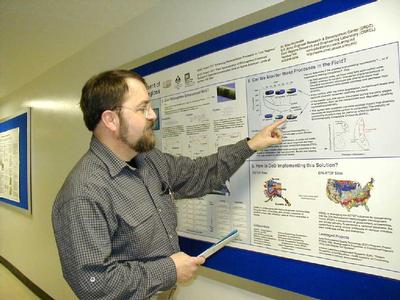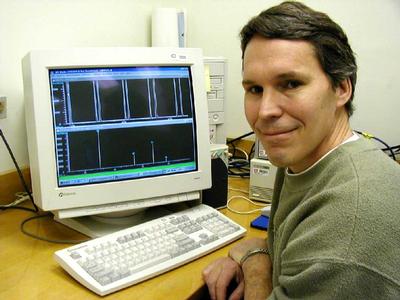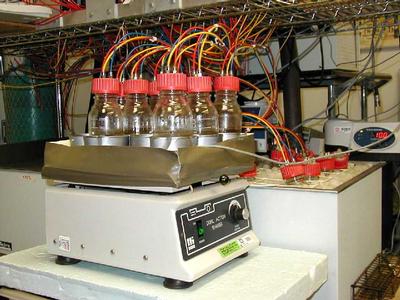9 April, 2001
C. M. (Mike) Reynolds, Research Soil Scientist, Bioremediation
Specializing in soil microbiology with a background in soil science, Mike
Reynolds is conducting research at the Cold Regions Research and Engineering
Laboratory (CRREL); Hanover, New Hampshire aimed at remediating contaminated
soil. Upon coming to CRREL, Dr. Reynolds applied his expertise in soils to
help the Army and DoD find cost effective ways to treat contaminated soils
in cold regions, such as remote installations from the cold war era. Dr.
Reynolds and his colleagues at CRREL, research microbiologist David
Ringelberg, and Research Technicians Larry Perry and Karen Swarts-Foley,
link microbiology with chemistry as they increase our ability to
beneficially influence soils.
The underlying commonality of the soil microbiology and bioremediation
research is to enhance natural phenomena so that we can more economically
treat sites. Field demonstrations, three in Alaska and the two in Korea, are
all faced with limited resources for treating contaminated soils. Cold
temperatures in Alaska prove challenging for conducting remediation of
contaminants, but both Alaska and Korea have manpower and resource
limitations. Cleanup is costly due to the remoteness of the sites and
limited alternatives. In cold regions, costs are further escalated because
of the short treatment season, relatively slow microbial activity and
permafrost at some of the sites.
With focus on the clean up of contaminated soils in the cold regions, Mike
Reynolds explains that fungi and bacteria can degrade or break down many
contaminants. Depending upon the variables involved, there are differing
degrees of this breakdown. Some contaminants are degraded entirely to
carbon dioxide and water. Other contaminants may degrade partially making
them a lesser environmental problem. CRREL's soil microbiology laboratory
finds way to make the degradation better.
One way to do this is by using the rhizosphere effect. The rhizosphere is
the zone of increased microbial growth and activity in the soil close to
plant roots. It is a root-soil relationship. Plant produce excess carbon
compounds by photosynthesis and exude these through their roots, where the
compounds stimulate soil microbial growth near the root surfaces. This in
turn stimulates bioremediation, the break down of contaminants in the soil.
Plants such as annual ryegrass and red fescue have dense, fibrous root
systems with tremendous surface area and they influence a greater percentage
of the soil than does a plant with a few large, thick roots. Rhizosphere
augmentation is faster and more complete than natural remediation of
contaminants and the benefits increase for the more challenging
contaminants.
Studies initially determined that contaminant degradation tends to be faster
and more complete in vegetation and nutrient treated soils. Similar results
have been found for diesel and crude-oil contaminated soils. Because
degradation occurs in the soil near the roots, plants do not take up
significant amounts petroleum contaminants. In contrast, plants used in the
bioremediation of metals in soils often function by taking up metals into
the plant tissue.
In cold regions, bioremediation may take several years because of short
growing seasons. Generally, soils may be bioremediated for thicknesses of
up to three or four feet of contamination.
In order to measure microorganisms in the soil, cellular components first
must be washed out or extracted from the soil. Mike Reynolds and his
colleagues then look at the soil extractions; quantify the cellular
components, and estimate microorganism abundance and composition.
In order to promote microbial growth in the soil, the soil is evaluated for
what needs to be added or altered. Soil moisture or temperature, for
example, may be altered to encourage microbial activity. Readings of carbon
dioxide are used as an indicator of growth of microbes. The respirometer,
an instrument for measuring carbon dioxide given off by microbes in the
soil, is used for conducting these assessments.
One of the greatest challenges is to determine what is happening to the soil
from the chemist's point of view. David Ringelberg interfaces microbiology
with organic chemistry and uses a variety of techniques to look at the soil.
For instance, he may recover lipids or DNA to conduct observations for
microorganisms.
For further information and contact information investigate Mike Reynold's
CRREL web page at:
http://www.crrel.usace.army.mil/es/personnel/reynolds.charles.html. To
explore the Soil Microbiology Lab and the Chemistry Lab at CRREL go to
http://www.crrel.usace.army.mil/welcome/facilities/crrel_facilities.html.
By Sandra Kolb, March 2001

Mike Reynolds at CRREL discussing the microbial numbers and microbial diversity of rhizosphere effects on contaminant concentrations. Photo by Sandra Kolb.

David Ringelberg in CRREL's bioanalytical laboratory. David is investigating the fatty acids recovered from bacterial cell membrane phosopholipids. Photo by Sandra Kolb.

A partial image of the respirometer in CRREL's soil microbiology laboratory. The respiromenter can measure microbial activity at constant or varied temperatures. Photo by Sandra Kolb.
Contact the TEA in the field at
.
If you cannot connect through your browser, copy the
TEA's e-mail address in the "To:" line of
your favorite e-mail package.
|
